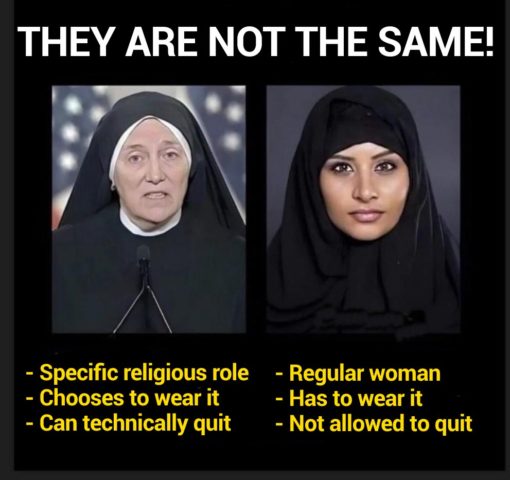THEY ARE NOT THE SAME Specific religious role Chooses to wear it Can technically quit Regular woman Has to wear it Not allowed to quit
The image is a side-by-side comparison of two women wearing head coverings and garments associated with religious practice. On the left, there's a woman dressed in a traditional Catholic nun's habit, including a black veil and white coif. On the right, there's a woman wearing a black hijab, which is commonly worn by Muslim women. The text at the top of the image states, "THEY ARE NOT THE SAME!"
Beneath each image are bullet points highlighting differences between the two women's situations as portrayed in the image. Under the nun, the points read: "Specific religious role," "Chooses to wear it," and "Can technically quit." By contrast, the points under the woman in the hijab read: "Regular woman," "Has to wear it," and "Not allowed to quit."
The humor in the image arises from the acknowledgment of a common superficial observation—that both women are wearing head coverings for religious reasons—while pointing out the deeper contextual differences. Essentially, it plays on the idea that while they might look similar to an uninformed observer, the underlying social, religious, and personal freedoms and choices involved are fundamentally different.
The image might be found amusing because it uses a straightforward visual structure, often seen in memes, to address a more complex intercultural subject. Humor is derived from the simplicity of the meme format tackling a nuanced issue, where the juxtaposition is clear and the conclusion is succinctly presented, inviting the viewer to reconsider any assumptions they might have held.
The humor also lies in the understated and deadpan way the information is presented. Rather than making an overt joke, the image relies on the viewer to understand and appreciate the irony inherent in the comparison. Also, for those who recognize the cultural complexities, there is an element of dark humor in the stark reality of the different levels of choice and freedom associated with each garment.
It's important to note, however, that humor is subjective and contingent upon a viewer's cultural background, knowledge, and beliefs. While some may find the image amusing for its concise delivery of a complex message, others may not find it humorous at all; instead, they might see it as a commentary on religious practices and gender roles. Further, the points made in the image, particularly regarding the woman in the hijab, are broad generalizations and might not accurately reflect the personal choice or the legal and social realities of all Muslim women. THEY ARE NOT THE SAME Specific religious role Chooses to wear it Can technically quit Regular woman Has to wear it Not allowed to quit
